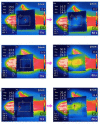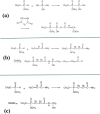Research advances in the fabrication of biosafety and functional leather: A way-forward for effective management of COVID-19 outbreak
- PMID: 35475140
- PMCID: PMC9023137
- DOI: 10.1016/j.jclepro.2021.127464
Research advances in the fabrication of biosafety and functional leather: A way-forward for effective management of COVID-19 outbreak
Abstract
With the recent events following the pandemic COVID-19, global awareness about the use of biosafety materials has been in raise. Leather industry being a major commodity-driven sector, its role in addressing the issues concerning the safe use of leather products has become inevitable for the sustainability of the industry. A significant number of researches have been conducted to fabricate bio-safe leather by incorporating different types of antimicrobial agents during leather manufacturing. Besides, the increasing diversity in the development of synthetic materials and the impact of COVID-19 outbreak on automotive industry may create more demand from customers for incorporating different functionalities in leather without losing its inherent properties. Some of the key functionalities discussed include resistance to microbial growth, self-cleaning through superhydrophobicity and photocatalysis, thermal regulation, flame retardance and scented leather. This review focusses on the fabrication of such advanced functional leather materials over the past decade with special emphasis on antimicrobial leather. Some of the key factors elaborated in the review include the state of art approaches for the preparation of functional materials, mode of incorporation of the same into the leather matrix, the mechanism behind with a perspective on the challenges involved in fabrication for real-world applications. A major outcome of this review is that even though several kinds of cutting edge researches are happening in the field of leather manufacturing, most of them were not validated for its practical applicability and sustainability of the proposed solution. This could be majorly attributed to the cost involved in fabrication of such materials, which forms a crucial factor when it comes to a mass production industry such as leather. Also, the researchers should concentrate on the toxicity of the fabricated materials which can impede the process of adopting such emerging and need of the hour technologies in the near future. Knowledge obtained from this review on fabrication of bio-safety leather against bacteria, mold and fungi would help further to integrate the antiviral property into the same which is a global need. Also, fabrication of functionalized leather would open new avenues for leather manufactures to venture into the development of advanced leather products such as flexible electronics, radiation shielding and fire fighting garments etc.
Keywords: Antimicrobial leather; Bio-safety; COVID-19; Functional materials; Leather.
© 2021 Elsevier Ltd. All rights reserved.
Conflict of interest statement
The authors declare that they have no known competing financial interests or personal relationships that could have appeared to influence the work reported in this paper.
Figures























References
-
- Aksoy A., Kaplan S. Production and performance analysis of an antibacterial foot sweat pad. Fibers Polym. 2013;14:316–323. doi: 10.1007/s12221-013-0316-z. - DOI
-
- Ayyappan V.G., Prakash D., Jaisankar S.N., Sadhukhan N., Alam M.S., Samanta D. Nanoconjugates of methacrylic polymers: synthesis, characterization, and immobilization to leather. J. Appl. Polym. Sci. 2020;137:48627. doi: 10.1002/app.48627. - DOI
-
- Babu H.V., Coluccini C., Wang D.-Y. In: Novel Fire Retardant Polymers and Composite Materials. Wang De-Yi., editor. Woodhead Publishing; 2017. 8 - functional layered double hydroxides and their use in fire-retardant polymeric materials; pp. 201–238. - DOI
Publication types
LinkOut - more resources
Full Text Sources
Miscellaneous
